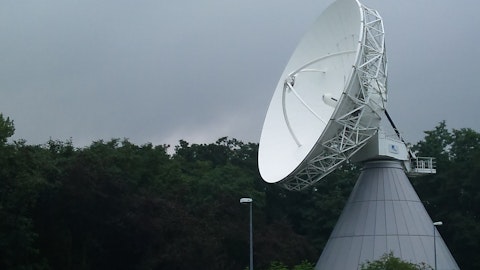The principal balance gets brought down. And then the third tranche is true third-party debt in our 13% notes, and I don’t think we have any immediate plans to address those. They’re paid half in pick, half in cash, and second lien. So market rate, at least at the time that we entered into them. So that’s — leverage is pretty good right now at under four times at the balance sheet date, and I think it’s expected to go down over the next couple of years. So it’s a pretty healthy level. I don’t know if that’s helpful, Mike, or if you follow-up.
Mike Crawford: Sure. I mean, those 13% notes are comparable, I believe, next March, but we’ll see. And then getting back to incorporating Band 53 into XCOM RAN, is there, what development work remains to be done there, and when will that be a unified solution you can offer to the market?
Kyle Pickens: Yes. As far as the exact technical work that needs to be done, I would defer to Paul. We can do a call with him later on. Originally, the XCOM RAN was based on a radio vendor called Baicells. We’re taking more of that in-house, and so there’s some technical work that the team needs to do. They are working on that right now. We think that we’ll have some POC type equipment later this year and then kind of a more full commercial launch shortly after that.
Mike Crawford: Okay. Thanks, Kyle. And then just going back a couple of years now, there’s been instances in the past where you’ve talked about perspective Band 53 customers or deployments, which have those other opportunities gone away or are they still in negotiation or…
Kyle Pickens: Yes, so that’s a good question. So we’re, you know, when we brought Paul and team on one of the reasons that, I mean, they’re. I can say that I think they’re the greatest wireless engineering team that anybody could have. And so, obviously, when we bring them on, we want to use their strengths and have them look at all the opportunities that we have. And not only are they great wireless engineering minds, they’re also great business minds. I mean, Paul and team built Qualcomm into a very, very substantial company. We wanted them to look at all the opportunities, and it’s Paul’s company to drive going forward and decide how he wanted to move forward. And so he looked at all of the opportunities. There was, I think, two that we’ve talked about in the past.
One of them we have moved forward on. They are paying us and will be deploying Band 53. The other one we have not move forward with yet. We could potentially in the future, but we are not moving forward with them at this moment. We have, instead focused on the project, like Jay was talking about with the government service project that’s very substantial and then things like the global retailer that we’ve talked about. So there’s — lots of opportunities ahead of us. We’re very, as Rebecca commented in her prepared remarks on. We’re very excited about where we’re going, but there’s, again, we had to defer to looking at all these opportunities and then high grading the ones that we think have the greatest long-term potential for the company overall.
Mike Crawford: Okay, thank you. And then final question just relates to the guidance. So what would be the major causes of variance between the low end and the high end range of revenue that you’ve indicated and are any spectrum license revenues consecrated in that guidance you gave.
Rebecca Clary: The answer is yes to the terrestrial piece though other things obviously could solidify, right, in the coming months. We’re still somewhat early. That could make a difference. But as we sit here today, the transactions that we expect to impact revenues are included. And so the variability is just that, right? I mean we’re talking about a lot of new deals and transactions, some of which we have a lot of certainty around the timing and the amounts. Others we don’t have as much, right? So as we move into the quarters like we did last year, we’ll tighten that range as appropriate and guide toward or guide towards a particular part of the range.
Mike Crawford: Excellent. Thank you.
Rebecca Clary: Thank you.
Operator: Your next question comes from the line of George Sutton from Craig-Hallum. Your line is open.
George Sutton: Thank you. Your deal with the retailer that you’ve mentioned, you’re working on certain Micro Fulfillment Centers. That retailer obviously has substantially more facilities. I’m curious what kinds of things need to be done to move them to a much broader footprint?
Jay Monroe: Yes. So, hi George, there’s a couple of things. There’s several internal things that they need to get through on some of their development issues. And then as far as our process is concerned, I think there’s — they’re really kind of focused on some reliability work. But there’s nothing that in our minds, I mean, we’re very confident about the service and product. I think they just need to see it work for longer and get more comfortable with it. But again, all the signs are encouraging so far.
George Sutton: So Qualcomm’s come up a couple times on the call and we had talked several months ago about Qualcomm creating a solution that they would take to market inclusive of Band 53. Can you give us any updates on if there’s progress there?
Jay Monroe: Yes. There’s definitely progress there. It’s — as a lot of you guys are, I mean we’re not. We’re impatient and obviously trying to push things as fast as we can. But in the end, we’re still a relatively small company working with a lot of really large companies. So it’s progress and we keep pushing them constantly and they’ve been very, very supportive. So definitely progress and we’ll keep driving.
George Sutton: Understand. And then lastly, a geeky question, which, Kyle, you would be perfect for. I think OTA testing using 10 megahertz gets you 4 to 5 times gains. Can you just explain what that means?



